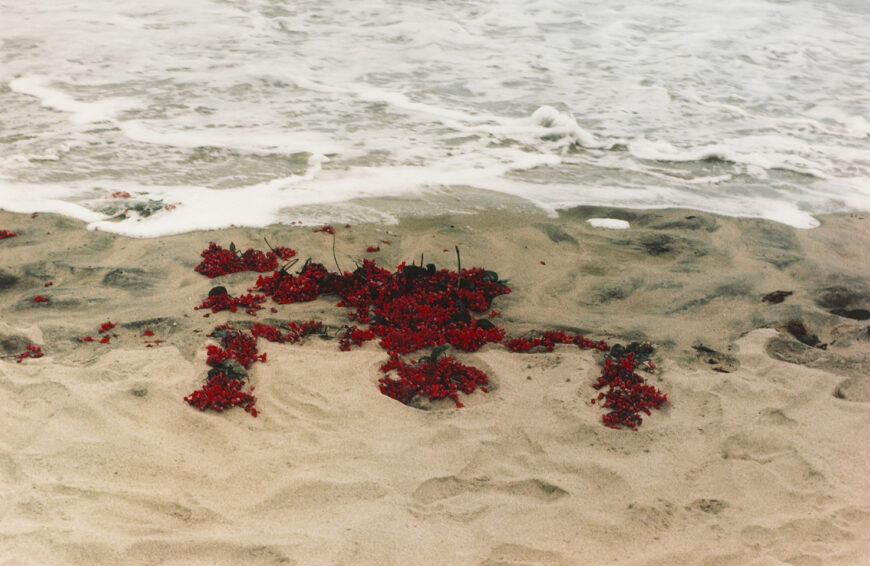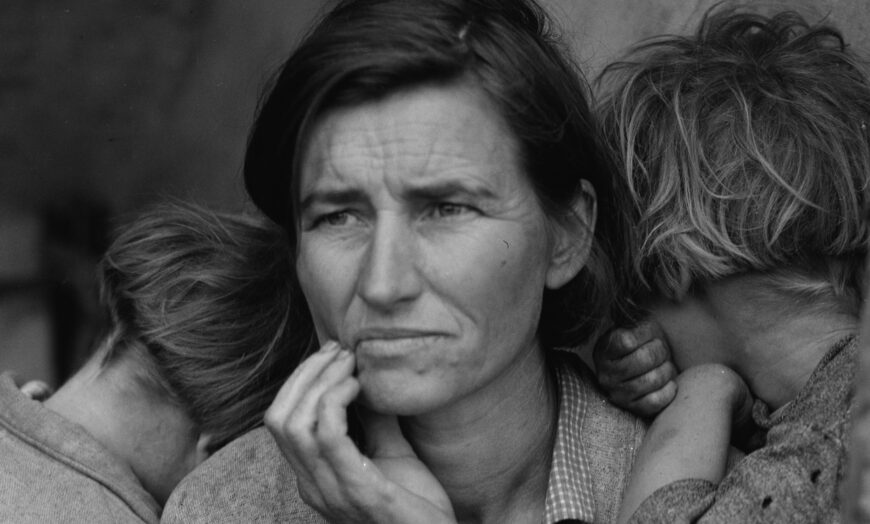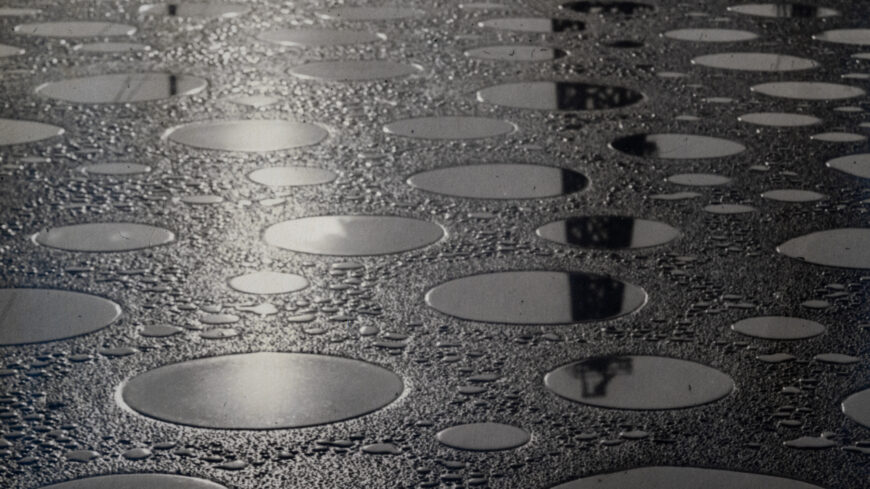Gordon Parks (American, 1912-2006), Off on My Own (Harlem, New York), 1948. Gelatin silver print. The Art Institute of Chicago, Amanda Taub Veazie Acquisition Fund, 2016.125. © The Gordon Parks Foundation. From “Harlem is Nowhere,” a collaborative project between Gordon Parks and Ralph Ellison. A Seeing America video. Speakers: Michal Raz-Russo, David and Sarajean Ruttenberg Associate Curator of Photography, Art Institute of Chicago and Dr. Steven Zucker Special thanks to Michal Raz-Russo, Sarah E. Alvarez, The Gordon Parks Foundation, the Ralph and Fanny Ellison Charitable Trust, and the Art Institute of Chicago.
Gordon Parks, Off on My Own (Harlem, New York)
[0:00] [music]
Dr. Steven Zucker: [0:06] We’re in the Photo Study Room in the Art Institute of Chicago, looking at this gorgeous print by Gordon Parks that was made in 1948. It shows a figure standing in an alley in Harlem.
Michal Raz-Russo: [0:20] This was made as part of a collaboration between Ralph Ellison and Gordon Parks. It was a project that Ellison conceived of just a year prior. It was his way of reacting to what he saw happening in the popular press.
[0:35] This was a time period when magazines like “Life” were extraordinarily popular. And the photo essay was seen as a great way of disseminating news stories and other topics of interest.
[0:47] Artists such as Ralph Ellison, who was an author, Gordon Parks a photographer, understood how those two elements, photograph, and text, could be used together to convey ideas that were important to them, in this case, ideas about racial inequalities in the US at the time.
[1:03] What they hoped to do was offer corrective representations of African American life but also point readers’ attention to the flaws and the manipulations present in mass media representations of African American life.
Dr. Zucker: [1:16] By 1948, Gordon Parks was a well-established photographer. He had been doing fashion photography for magazines like “Vogue” and he would become a staff photographer for “Life” magazine.
Michal: [1:27] We could even go further back than that. The work that he did for the Farm Security Administration and the Office of War Information had gotten him a great reputation as a photographer who was able to capture the humanity of his subjects. That was something that Ralph Ellison became immediately aware of.
Dr. Zucker: [1:43] Ralph Ellison was at this time at work on what would become his most famous novel, “Invisible Man.”
Michal: [1:49] What a lot of people don’t know is that Ellison was himself working as a photographer to supplement his income. In his spare time, he was walking around Harlem, taking photographs that were used as studies for passages in his texts.
Dr. Zucker: [2:03] It’s important to remember that Harlem, in the years before the Second World War, had been the center of Black American culture. This was where the Harlem Renaissance was centered.
Michal: [2:12] In 1935 and in 1943, two riots take place in Harlem. In the mass media, Harlem becomes a symbol of economic hardship, of racial inequality, of all these stereotypes that were given to African Americans.
Dr. Zucker: [2:28] One of the narratives that develops in the postwar era in major cities like New York is urban decay. It is just within this period that we begin to see white flight and the growth of the suburbs. You have the abandonment by white America of the cities and this portrayal of the city as this wasteland.
Michal: [2:47] Ellison was approached to write an essay for a magazine called “The Magazine of the Year.” They’d asked him to write about Harlem, and he pitched a story centered on the Lafargue Clinic.
Dr. Zucker: [2:59] This was the first non-segregated psychiatric clinic in New York, and would have a profound impact on the history of segregation.
Michal: [3:07] Anybody could come there, and it ended up being an important social space within Harlem, and Ellison saw this as a perfect metaphor for everything that was going on in Harlem at the time.
[3:16] The argument that he sought to make in his essay was that the psychological effects of living in a segregated place, of racism, gave the residents of places like Harlem no choice but to be so troubled and to need this kind of help.
Dr. Zucker: [3:32] But the photographs were not produced as illustrations for the text but in fact were made earlier.
Michal: [3:38] Ellison wrote a manifesto for Gordon Parks prior to them beginning work on the project that explained to him the goals he hoped to accomplish with those images. One of the key phrases in that manifesto is instructing Parks to make images that serve as both document and symbol.
[3:54] The idea that the photographs were not simply meant to depict Harlem or even illustrate passages in the essay, he wanted the photographs to do something that the text could not.
[4:05] They go out together, photograph side-by-side over several weeks in the winter. Once they are done, Ellison writes the essay as a response to Parks’ photographs. Then he writes captions to accompany the dozen or so photographs that were meant to illustrate the essay.
[4:19] The essay was titled “Harlem is Nowhere,” but what comes across is this idea that Harlem is in fact everywhere. The problems that are present in Harlem represent larger systemic issues across America.
Dr. Zucker: [4:32] That are socioeconomic, but that are also psychological.
Michal: [4:36] They submit the essay to “The Magazine of the Year.” However, just weeks before publication, Ellison gets a note that the magazine has to declare bankruptcy and all of the materials have now become part of the legal proceedings and they cannot be returned.
[4:50] So the story goes unpublished, and the essay “Harlem is Nowhere,” doesn’t get published until 1964, without Gordon Parks’ photographs. One of the things that we were able to uncover through research for this project is not just the photographs that we believe belong to the essay, but also the captions that Ellison wrote, which are just as important as the text of the essay.
Dr. Zucker: [5:11] Let’s take a moment to read the caption that was associated with this print. “Who am I? Where am I? How do I come to be? Behind the endless walls of his ghetto man searches for social identity. Refugees from southern feudalism, many Negroes wander dazed in the mazes of northern ghettos, the displaced persons of American democracy.”
Michal: [5:33] This image is the one that introduces Harlem to readers. The image that immediately follows this describes Harlem as a physical ruin that, for many, represents a psychological maze.
Dr. Zucker: [5:45] The photograph that that’s associated with, this third image, shows the rooftops of brownstones in Harlem, with the divisions at the rooftop especially apparent so that the city looks like a maze.
Michal: [5:57] Serves to use Ellison’s own words as both a document and a symbol.
Dr. Zucker: [6:01] This is photographed from above, but the previous image is so much more intimate and is taken from a lower vantage point, where we’re looking up at this tall figure, encased in an environment that is overwhelming.
Michal: [6:13] This idea that Harlem is everywhere, that Harlem residents represent everyone. It also foreshadows “Invisible Man.”
[6:22] The opening sentences to the novel read, “I’m invisible, understand, simply because people refuse to see me. Like the bodiless heads you see sometimes in circus sideshows, it is as though I have been surrounded by mirrors of hard, distorting glass. When they approach me they see only my surroundings, themselves, or figments of their imagination–indeed, everything and anything except me.”
[6:45] You see the silhouette, you only see his surroundings. You’re unable to make any assessments of who he is.
Dr. Zucker: [6:53] But Ellison also implicates his reader. Is his invisibility our responsibility? Is it because we refuse to see him? When I look at this photograph, I ask the same question. Is this man invisible because I don’t know him?
Michal: [7:05] He tries to make real for readers the psychological effects of segregation and racism. And make them as relatable and understandable as possible. He’s making you understand that this is not something that is separate from our experiences of America. This is America.
[7:25] [music]
| Title | Off on My Own (Harlem, New York) |
| Artist(s) | Gordon Parks |
| Dates | 1948 |
| Places | North America / United States |
| Period, Culture, Style | Modernisms / Civil Rights era |
| Artwork Type | Photography |
| Material | |
| Technique | Gelatin silver process |
Learn more about this photo from the Art Institute of Chicago
Visit the website of the Gordon Parks Foundation
Gordon Parks Interprets Ralph Ellison’s “Invisible Man” (MoMA video)
Read an excerpt from “Harlem is Nowhere”
Learn more about the collaboration between Parks and Ellison from the Art Institute of Chicago
Learn about the development of suburbs in the post-war era
See some of Parks’s photographs for LIFE Magazine and others
Read an interview with Gordon Parks
Learn about the life of Ralph Ellison
See videos and other primary sources about Invisible Man
Test your knowledge with a quiz
Parks, Off On My Own
Key points
- The mass media’s portrayal of urban spaces like Harlem in the years after World War II often reinforced negative stereotypes of African Americans. Photographer Gordon Parks and writer Ralph Ellison wanted to offer corrective views of African American life in the popular press. This led them to collaborate on the 1948 essay “Harlem is Nowhere.”
- The text of the essay focused on the Lafargue Clinic, the first non-segregated psychiatric clinic in New York. Ellison argued that segregation and racism were having negative psychological effects on African Americans, and that problems present in Harlem represented larger systemic issues across America. These are issues he would tackle in his famous book, Invisible Man.
- The photographs by Parks were not meant to illustrate the essay. They present their own visual argument about the tensions around race in both Harlem and the United States more broadly by portraying the psychological and societal difficulties that were a daily part of the African American experience.
More to think about
Re-read the caption that Ellison wrote for this photograph:
“Who am I? Where am I? How do I come to be? Behind endless walls of his ghetto, man searches for social identity. Refugees from southern feudalism, many Negroes wander dazed in the mazes of northern ghettos, the displaced persons of American democracy.”
Which details of Parks’s image seem specifically addressed by Ellison’s caption? How do you think Ellison’s choice of words affects the way we interpret the photograph?





